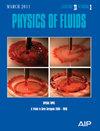基于深度学习的气液两相气泡流气泡快速跟踪和监测算法
IF 4.1
2区 工程技术
Q1 MECHANICS
引用次数: 0
摘要
气液两相气泡流在多个领域都有重要应用,包括化学工程中的反应器设计和分离过程、石油和天然气行业中的油井开采和管道运输、核工业中的冷却系统以及环境工程中的废水处理。在这些应用中,气泡监测至关重要,因为它可以提高传质和传热效率,改善流动稳定性,并确保系统安全运行。本研究开发了一种先进的算法,旨在利用语义分割技术精确检测和分割气液界面上的小气泡。该技术利用深度学习模型分析图像,自动识别气液界面上的气泡,并准确划分其边界。该技术可为每个气泡提供精确的轮廓,为进一步的气泡动力学分析提供重要的基础数据。在此基础上,深度学习检测算法与深度关联度量(DeepSORT)算法、深度简单在线和实时跟踪算法相结合,使系统能够快速、准确地识别和跟踪同一气泡在连续帧中的移动。本文章由计算机程序翻译,如有差异,请以英文原文为准。
A deep learning-based algorithm for rapid tracking and monitoring of gas–liquid two-phase bubbly flow bubbles
Gas–liquid two-phase bubbly flow has significant applications across multiple fields, including reactor design and separation processes in chemical engineering, oil well extraction and pipeline transportation in the oil and gas industry, cooling systems in the nuclear industry, and wastewater treatment in environmental engineering. Bubble monitoring is crucial in these applications as it can enhance mass and heat transfer efficiency, improve flow stability, and ensure the safe operation of systems. This study developed an advanced algorithm aimed at precisely detecting and segmenting small bubbles at the gas–liquid interface using semantic segmentation techniques. This technology leverages deep learning models to analyze images, automatically identifying bubbles at the gas–liquid interface and accurately delineating their boundaries. The technique provides precise contours for each bubble, offering essential foundational data for further bubble dynamics analysis. Building on this, the deep learning detection algorithm was combined with the Deep Simple Online and Realtime Tracking with a Deep Association Metric (DeepSORT) algorithm, tracking algorithm, enabling the system to rapidly and accurately identify and track the movement of the same bubble across consecutive frames.
求助全文
通过发布文献求助,成功后即可免费获取论文全文。
去求助
来源期刊

Physics of Fluids
物理-力学
CiteScore
6.50
自引率
41.30%
发文量
2063
审稿时长
2.6 months
期刊介绍:
Physics of Fluids (PoF) is a preeminent journal devoted to publishing original theoretical, computational, and experimental contributions to the understanding of the dynamics of gases, liquids, and complex or multiphase fluids. Topics published in PoF are diverse and reflect the most important subjects in fluid dynamics, including, but not limited to:
-Acoustics
-Aerospace and aeronautical flow
-Astrophysical flow
-Biofluid mechanics
-Cavitation and cavitating flows
-Combustion flows
-Complex fluids
-Compressible flow
-Computational fluid dynamics
-Contact lines
-Continuum mechanics
-Convection
-Cryogenic flow
-Droplets
-Electrical and magnetic effects in fluid flow
-Foam, bubble, and film mechanics
-Flow control
-Flow instability and transition
-Flow orientation and anisotropy
-Flows with other transport phenomena
-Flows with complex boundary conditions
-Flow visualization
-Fluid mechanics
-Fluid physical properties
-Fluid–structure interactions
-Free surface flows
-Geophysical flow
-Interfacial flow
-Knudsen flow
-Laminar flow
-Liquid crystals
-Mathematics of fluids
-Micro- and nanofluid mechanics
-Mixing
-Molecular theory
-Nanofluidics
-Particulate, multiphase, and granular flow
-Processing flows
-Relativistic fluid mechanics
-Rotating flows
-Shock wave phenomena
-Soft matter
-Stratified flows
-Supercritical fluids
-Superfluidity
-Thermodynamics of flow systems
-Transonic flow
-Turbulent flow
-Viscous and non-Newtonian flow
-Viscoelasticity
-Vortex dynamics
-Waves
 求助内容:
求助内容: 应助结果提醒方式:
应助结果提醒方式:


